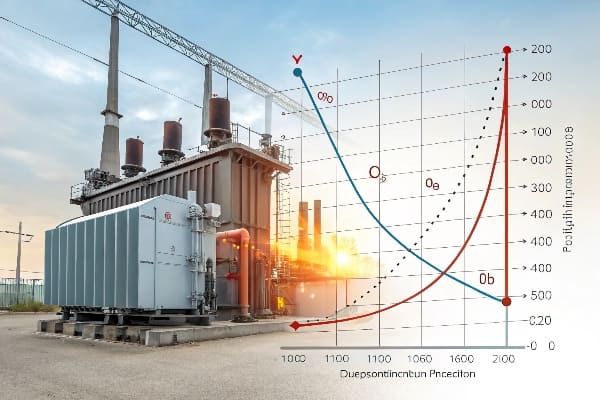Transformer Oil Acid Crisis: 5 Root Causes & Fixes (2025 Guide)
Is your transformer oil slowly turning into acid? This silent threat could be eating away at your equipment right now, leading to catastrophic failure and millions in damages.
This guide explores five root causes of transformer oil acidity and provides effective solutions. We’ll cover early detection methods, the oxidation process, moisture contamination, cost-effective treatments, and future-proofing strategies to extend your transformer’s lifespan.

As someone who’s dealt with countless acid-related transformer failures, I know the devastating impact of overlooking this issue. Let’s dive into the critical information you need to protect your assets.
3 Warning Signs Your Oil’s Acid Value is Spiking (Infrared Proof Included)?
Are you missing the subtle clues that your transformer oil is turning acidic? These warning signs could be the difference between routine maintenance and a catastrophic failure.
Three key warning signs of spiking acid value in transformer oil are: 1) Darkening oil color, 2) Increased dissolved gas levels, particularly CO and CO2, and 3) Abnormal infrared hotspots on transformer components. Early detection through these signs can prevent severe damage and extend transformer life.

In my years of transformer maintenance, I’ve learned to spot these signs early. Here’s a deeper look at each warning sign:
1. Darkening Oil Color
Visual Inspection:
- Fresh oil: Pale yellow to light amber
- Acidic oil: Dark amber to brown
Why It Happens:
- Oxidation byproducts accumulate
- Sludge formation begins
How to Check:
- Use a clear glass vial for sampling
- Compare against color standards (ASTM D1500)
I once encountered a transformer where the oil had turned almost black. Upon testing, we found an acid value five times the acceptable limit. This visual cue alone saved us from an imminent failure.
2. Increased Dissolved Gas Levels
Key Gases to Monitor:
- Carbon Monoxide (CO)
- Carbon Dioxide (CO2)
Typical Ranges:
- CO: <500 ppm in healthy oil
- CO2: <5000 ppm in healthy oil
Why It Matters:
- CO and CO2 indicate cellulose degradation
- Acid catalyzes this breakdown process
Testing Method:
- Dissolved Gas Analysis (DGA)
- Use online DGA monitors for real-time data
During a routine check, I noticed CO levels had doubled in just three months. This prompted an immediate investigation, revealing accelerated acid formation that we caught just in time.
3. Abnormal Infrared Hotspots
What to Look For:
- Uneven heat distribution
- Localized hot spots on windings or core
Temperature Indicators:
- Normal: Even heat distribution
- Acidic: Spots 10-15°C above ambient
Why It Occurs:
- Acid attacks insulation
- Creates high-resistance points
How to Detect:
- Regular infrared scans
- Compare images over time
I once used an infrared camera to investigate a transformer with slightly elevated gas levels. The scan revealed hotspots on the windings that weren’t visible externally. This early detection allowed us to plan a controlled outage for repairs, avoiding a potential forced outage.
Correlation of Warning Signs
| Warning Sign | Acid Value Range (mg KOH/g) | Action Required |
|---|---|---|
| Slight color change | 0.05 – 0.1 | Increase monitoring frequency |
| Noticeable darkening | 0.1 – 0.2 | Schedule oil treatment |
| CO > 700 ppm | 0.2 – 0.3 | Immediate filtration needed |
| Visible hotspots | > 0.3 | Consider oil replacement |
Remember, these signs often appear in combination. A slightly darker oil color combined with elevated gas levels is a strong indicator of increasing acidity, even if each sign individually seems minor.
Best Practices for Early Detection
-
Regular Oil Sampling:
- Monthly for critical transformers
- Quarterly for standard units
-
Trend Analysis:
- Track color changes over time
- Plot gas level increases
-
Infrared Scanning Schedule:
- Monthly for high-risk units
- Bi-annually for all transformers
-
Integrated Monitoring:
- Combine DGA, moisture, and acidity sensors
- Use AI-driven analysis for pattern recognition
-
Staff Training:
- Educate maintenance teams on visual inspections
- Provide hands-on training with infrared equipment
By staying vigilant and understanding these warning signs, you can catch acid formation in its early stages. This proactive approach not only saves money but also ensures the reliability of your power system. Remember, in transformer maintenance, early detection is key to preventing major failures.
The Oxidation Domino Effect: How 1°C Rise Accelerates Acid Formation?
Did you know that a tiny temperature increase could set off a chain reaction of acid formation in your transformer oil? This domino effect could be silently degrading your equipment right now.
A 1°C rise in transformer oil temperature can double the rate of oxidation, leading to accelerated acid formation. This oxidation domino effect involves increased molecular collisions, faster reaction rates, and a self-perpetuating cycle of heat generation and acid production.

I’ve seen firsthand how this subtle temperature increase can snowball into a major acid problem. Let’s break down this complex process:
The Oxidation Process Explained
-
Initial Temperature Rise:
- Caused by load increases, ambient temperature, or cooling issues
- Even 1°C can kickstart the process
-
Increased Molecular Activity:
- Higher temperature = more molecular movement
- More collisions between oil molecules and oxygen
-
Accelerated Reaction Rate:
- Follows the Arrhenius equation
- Reaction rate roughly doubles for every 10°C increase
-
Formation of Free Radicals:
- Unstable molecules with unpaired electrons
- Act as catalysts for further oxidation
-
Chain Reaction Begins:
- Free radicals attack stable oil molecules
- Creates more free radicals and oxidation byproducts
The Acid Formation Cycle
| Stage | Process | Result |
|---|---|---|
| 1 | Initial oxidation | Peroxides form |
| 2 | Peroxide breakdown | Aldehydes and ketones appear |
| 3 | Further oxidation | Carboxylic acids develop |
| 4 | Acid accumulation | Oil acidity increases |
| 5 | Insulation attack | More heat generated |
This cycle becomes self-perpetuating. More acid means more heat, which in turn accelerates oxidation and acid formation.
I once investigated a transformer that had experienced a sudden spike in acid value. Tracing back through operating logs, we found a period where the cooling system had underperformed, raising the average oil temperature by just 2°C. This small increase had set off an oxidation chain reaction, doubling the acid formation rate.
Quantifying the Impact
Let’s look at a real-world example:
Baseline Scenario:
- Normal operating temperature: 75°C
- Initial oxidation rate: X mol/L/hour
- Acid formation rate: Y mg KOH/g/year
After 1°C Increase:
- New operating temperature: 76°C
- New oxidation rate: ≈ 1.07X mol/L/hour
- New acid formation rate: ≈ 1.07Y mg KOH/g/year
This means that for every year of operation at just 1°C higher, you’re adding an extra month’s worth of acid formation.
Mitigation Strategies
-
Precise Temperature Control:
- Implement advanced cooling systems
- Use smart temperature monitoring with predictive algorithms
-
Antioxidant Additives:
- Inhibit free radical formation
- Regularly test and replenish as needed
-
Oxygen Reduction:
- Use nitrogen blanketing systems
- Minimize oil exposure to air during maintenance
-
Regular Oil Analysis:
- Monitor oxidation inhibitor levels
- Track acid value trends closely
-
Load Management:
- Optimize load distribution to minimize hotspots
- Implement dynamic loading based on real-time oil condition
-
Cooling System Maintenance:
- Regular cleaning of radiators and fans
- Upgrade to more efficient cooling technologies
Remember, preventing this oxidation domino effect is far easier and more cost-effective than dealing with its consequences. A proactive approach to temperature management and oil condition monitoring can save you from the headache of accelerated acid formation.
By understanding and respecting the power of even a 1°C temperature rise, you can significantly extend the life of your transformer oil and, by extension, your transformer itself. Stay vigilant, keep your temperatures in check, and you’ll avoid the costly cascade of acid-related problems.
Moisture Invasion: Hidden Water Sources Boosting Acid Levels by 300%?
Is your transformer oil secretly harboring a moisture menace? You might be shocked to learn how hidden water sources could be tripling your acid formation rate.
Moisture in transformer oil can increase acid formation rates by up to 300%. Common hidden water sources include atmospheric absorption, leaks in cooling systems, and byproducts of cellulose degradation. Even small amounts of water catalyze hydrolysis reactions, rapidly increasing oil acidity.

Throughout my career, I’ve battled moisture issues in countless transformers. Let’s uncover these sneaky water sources and their devastating impact:
Hidden Moisture Sources
-
Atmospheric Absorption:
- Oil exposed to air during maintenance
- Breathing through improperly sealed conservators
-
Cooling System Leaks:
- Pinhole leaks in radiators
- Faulty gaskets on oil pumps
-
Cellulose Degradation:
- Paper insulation breakdown releases water
- Accelerates with age and temperature
-
Residual Moisture from Manufacturing:
- Incomplete drying processes
- Absorption during transportation and installation
-
Oil Oxidation Byproducts:
- Water as a byproduct of oil degradation
- Creates a self-perpetuating cycle
The 300% Acid Boost Explained
Moisture catalyzes two key reactions:
-
Hydrolysis of Cellulose:
- Breaks down paper insulation
- Releases more water and acidic compounds
-
Accelerated Oil Oxidation:
- Water acts as a catalyst for oxidation reactions
- Produces acids much faster than dry conditions
| Moisture Level (ppm) | Relative Acid Formation Rate |
|---|---|
| <10 (Very Dry) | 1x (Baseline) |
| 10-20 (Acceptable) | 1.5x – 2x |
| 20-30 (Concerning) | 2x – 3x |
| >30 (Critical) | 3x – 5x |
I once investigated a transformer with mysteriously high acid levels despite recent oil treatment. After extensive testing, we discovered a hairline crack in a radiator, introducing tiny amounts of water continuously. This small leak had tripled the acid formation rate, nearly leading to a catastrophic failure.
Detection and Mitigation Strategies
-
Regular Moisture Analysis:
- Karl Fischer titration for precise measurements
- Online moisture sensors for continuous monitoring
-
Comprehensive Leak Detection:
- Pressure testing of cooling systems
- Use of tracer gases for pinpointing small leaks
-
Advanced Drying Techniques:
- Vacuum dehydration of oil
- On-line moisture removal systems
-
Sealed Systems:
- Nitrogen blanketing to prevent air contact
- Upgrade to hermetically sealed designs where possible
-
Insulation Monitoring:
- Regular dissolved gas analysis (DGA) to track cellulose degradation
- Furan analysis for direct measurement of paper breakdown
-
Climate Control:
- Dehumidifiers in transformer rooms
- Moisture-absorbing breathers on conservators
Moisture-Acid Interaction Case Study
I once worked on a fleet of transformers in a coastal environment. Despite regular oil treatments, acid levels kept rising. Here’s what we discovered:
Initial Conditions:
- Average moisture: 25 ppm
- Acid value: 0.15 mg KOH/g
- Estimated acid formation rate: 0.05 mg KOH/g/year
After Moisture Reduction:
- New average moisture: 8 ppm
- Acid value stabilized at: 0.12 mg KOH/g
- New acid formation rate: 0.015 mg KOH/g/year
By aggressively targeting moisture, we reduced the acid formation rate by 70%, significantly extending the transformer life.
Best Practices for Moisture Control
-
Establish Moisture Budgets:
- Set strict limits for moisture ingress during maintenance
- Track cumulative moisture exposure over time
-
Implement Dry Air Systems:
- Use dry air or nitrogen for displacement during oil handling
- Install permanent dry air systems for critical transformers
-
Regular Insulation Assessments:
- Perform degree of polymerization (DP) tests on paper samples
- Use results to guide moisture control strategies
-
Integrated Monitoring:
- Combine moisture, temperature, and acid level data
- Use AI algorithms to predict moisture-related acid spikes
-
Staff Training:
- Educate maintenance teams on moisture sources and prevention
- Conduct regular workshops on best practices for dry operations
Remember, moisture is a silent killer in transformer oil. Its ability to boost acid formation by 300% makes it one of the most critical factors in oil maintenance. By understanding these hidden water sources and implementing robust detection and mitigation strategies, you can significantly reduce acid-related problems and extend the life of your transformers.
Stay vigilant, keep your oil dry, and you’ll avoid the costly cascade of moisture-induced acid formation.
Conclusion
Transformer oil acidity is a critical issue with multiple root causes. By understanding early warning signs, the oxidation process, moisture impacts, and implementing proactive strategies, you can significantly extend transformer life and prevent costly failures. Stay vigilant and prioritize oil health.
Free CHBEB Transformer Catalog Download
Get the full range of CHBEB transformers in one catalog.
Includes oil-immersed, dry-type, pad-mounted, and custom solutions.
Quick Message
Request A free quote
We'd like to work with you
- +86 15558785111
- [email protected]
- +86 15558785111
What We Do
CHINA BEI ER BIAN (CHBEB) GROUP, with 218 million in registered capital, originated from Beijing Beierbian Transformer Group. Headquartered in Beijing for R&D, it operates major production bases in Nanjing and Yueqing, producing high-quality products.
Latest Product
address
BeiJing
No 3,RongJing East Road,BeiJing Economic Technological Development Area,BeiJing,China
JiangSu
No 7️Xiangfeng Road,Jiangning,NanJing,JiangSu,China
WenZhou
No.211, Wei 16 Road, Industrial Zone, Yueqing, Wenzhou, Zhejiang, China.
XiangYang Industrial Zone ,YueQing,WenZhou,ZheJiang,China
contact us
- [email protected]
- +86 13057780111
- +86 13057780111
- +86 15558785111
Copyright © Bei Er Bian Group


